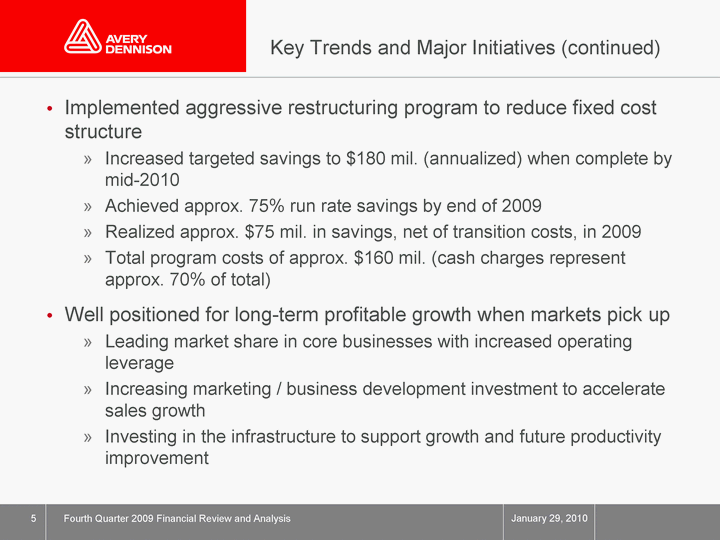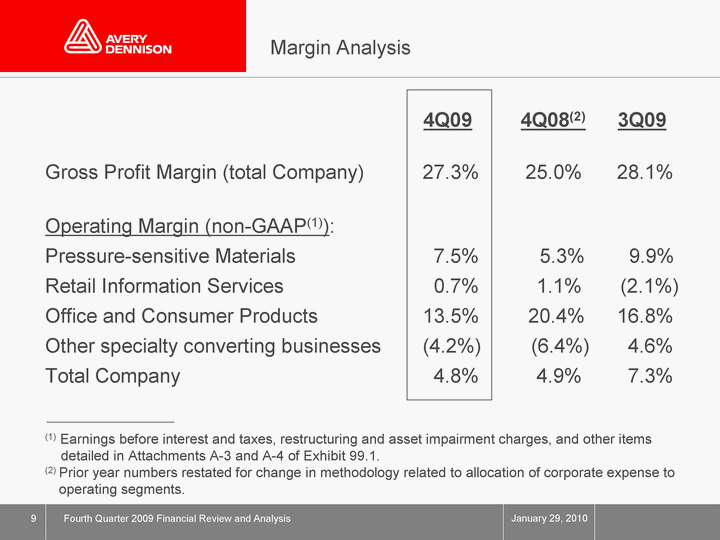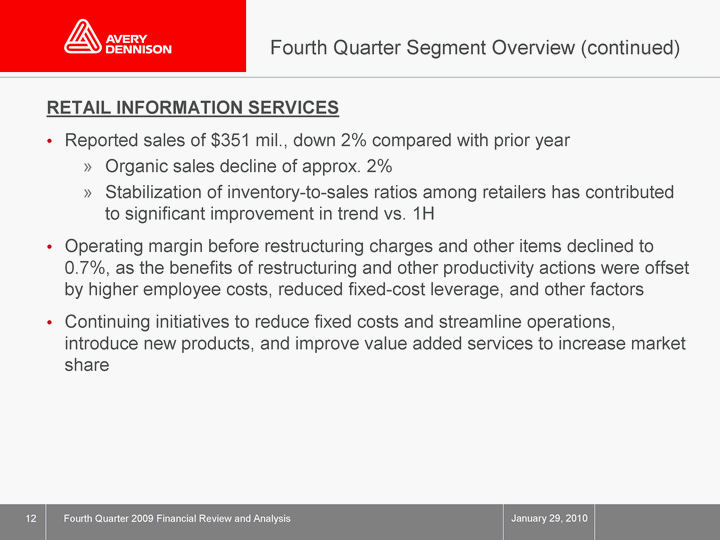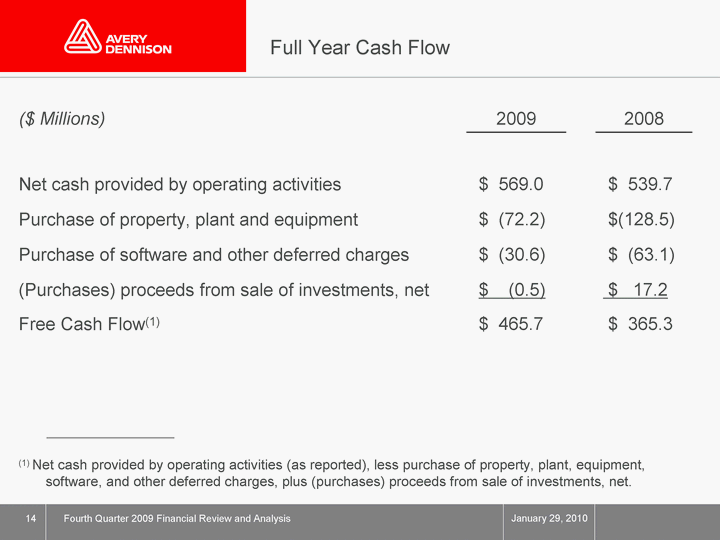Attached files
| file | filename |
|---|---|
| 8-K - FORM 8-K - Avery Dennison Corp | v54966e8vk.htm |
| EX-99.3 - EX-99.3 - Avery Dennison Corp | v54966exv99w3.htm |
| EX-99.1 - EX-99.1 - Avery Dennison Corp | v54966exv99w1.htm |
Exhibit 99.2

| Supplemental Presentation Materials Fourth Quarter Financial Review and Analysis (unaudited) January 29, 2010 |

| Certain statements contained in this document are "forward-looking statements" intended to qualify for the safe harbor from liability established by the Private Securities Litigation Reform Act of 1995. Such forward-looking statements and financial or other business targets are subject to certain risks and uncertainties. Actual results and trends may differ materially from historical or anticipated results depending on a variety of factors, including but not limited to risks and uncertainties relating to investment in development activities and new production facilities; fluctuations in cost and availability of raw materials; ability of the Company to achieve and sustain targeted cost reductions; ability of the Company to generate sustained productivity improvement; successful integration of acquisitions; successful implementation of new manufacturing technologies and installation of manufacturing equipment; the financial condition and inventory strategies of customers; customer and supplier concentrations; changes in customer order patterns; loss of significant contract(s) or customer(s); timely development and market acceptance of new products; fluctuations in demand affecting sales to customers; impact of competitive products and pricing; selling prices; business mix shift; volatility of capital and credit markets; impairment of capitalized assets, including goodwill and other intangibles; credit risks; ability of the Company to obtain adequate financing arrangements and to maintain access to capital; fluctuations in interest and tax rates; fluctuations in pension, insurance and employee benefit costs; impact of legal proceedings, including a previous government investigation into industry competitive practices, and any related proceedings or lawsuits pertaining thereto or to the subject matter thereof related to the concluded investigation by the U.S. Department of Justice ("DOJ") (including purported class actions seeking treble damages for alleged unlawful competitive practices, which were filed after the announcement of the DOJ investigation), as well as the impact of potential violations of the U.S. Foreign Corrupt Practices Act; changes in tax laws and regulations; changes in governmental regulations; changes in political conditions; fluctuations in foreign currency exchange rates and other risks associated with foreign operations; worldwide and local economic conditions; impact of epidemiological events on the economy and the Company's customers and suppliers; acts of war, terrorism, and natural disasters; and other factors. The Company believes that the most significant risk factors that could affect its financial performance in the near- term include (1) the impact of economic conditions on underlying demand for the Company's products and on the carrying value of its assets; (2) the impact of competitors' actions, including pricing, expansion in key markets, and product offerings; and (3) the degree to which higher costs can be offset with productivity measures and/or passed on to customers through selling price increases, without a significant loss of volume. The financial information presented in this document represents preliminary, unaudited financial results. 2 |

| Use of Non-GAAP Financial Measures This presentation contains certain non-GAAP measures as defined by SEC rules. The most directly comparable GAAP measures have been included in the earnings news release for the quarter. Reconciliations of non-GAAP measures to the most directly comparable GAAP measures are included with the financial schedules accompanying the earnings news release for the quarter, along with certain supplemental analysis provided in this document. (See Attachments A-2 through A-5 to Exhibit 99.1, news release dated January 29, 2010.) The Company's non-GAAP financial measures exclude the impact of certain events, activities or strategic decisions. The accounting effects of these events, activities or decisions, which are included in the GAAP measures, may make it difficult to assess the underlying performance of the Company in a single period. By excluding certain accounting effects, both positive and negative (e.g. restructuring charges, asset impairments, legal settlement costs, certain effects of acquisitions and related integration costs, loss from debt extinguishment, gains on sales of assets, etc.), from certain of the Company's GAAP measures, the Company believes that it is providing meaningful supplemental information to facilitate an understanding of the Company's "core" or "underlying" operating results. These non-GAAP measures are used internally to evaluate trends in the Company's underlying business, as well as to facilitate comparison to the results of competitors for a single period. The Company adjusted the estimated GAAP tax rate to exclude the full year estimated tax rate effect of charges for goodwill and indefinite-lived intangible asset impairments, restructuring costs and asset impairment and lease cancellation charges, legal settlement costs, loss from debt extinguishment, transition costs associated with acquisition integrations and gain on sale of investments to determine its adjusted non-GAAP tax rate to derive non-GAAP net income. (See Attachment A-2 to Exhibit 99.1 for discussion of limitations associated with the use of these non-GAAP measures.) The information in this document has been furnished (not filed) under Form 8-K with the SEC and is posted at the Investors section of the Company's Web site. 3 |

| Key Trends and Major Initiatives Delivered record free cash flow for the year of approx. $465 mil. Reduced debt by approx. $300 mil. in 2H09 Dramatically improved working capital productivity Reduced capital spending Reduced dividend While weakness in the macroeconomic environment drove volume declines in all segments, the rate of volume decline continued to improve through the second half End markets remain soft Inventory levels in many markets appear to be stabilizing Q4 benefit from easier prior year comparisons January 29, 2010 Fourth Quarter 2009 Financial Review and Analysis 4 |

| Key Trends and Major Initiatives (continued) Implemented aggressive restructuring program to reduce fixed cost structure Increased targeted savings to $180 mil. (annualized) when complete by mid-2010 Achieved approx. 75% run rate savings by end of 2009 Realized approx. $75 mil. in savings, net of transition costs, in 2009 Total program costs of approx. $160 mil. (cash charges represent approx. 70% of total) Well positioned for long-term profitable growth when markets pick up Leading market share in core businesses with increased operating leverage Increasing marketing / business development investment to accelerate sales growth Investing in the infrastructure to support growth and future productivity improvement January 29, 2010 Fourth Quarter 2009 Financial Review and Analysis 5 |

| Fourth Quarter Summary Net sales grew approx. 1% from prior year Currency translation increased sales by 5% On an organic basis(1), net sales were down approx. 1% vs. prior year Operating margin declined modestly to 4.8% before restructuring, asset impairment charges, lease cancellation costs, and other items At the gross profit level, restructuring and productivity initiatives more than offset the margin impact of the volume decline The effect of pricing and raw material cost trends has offset the cumulative impact of 2008 inflation, contributing to year-on-year gross margin improvement for the quarter Gross margin improvement was offset by a higher MG&A ratio 6 Fourth Quarter 2009 Financial Review and Analysis January 29, 2010 (1) Throughout this document, all references to organic sales change refer to results before the impact of acquisitions, foreign currency translation, and an extra week in the first quarter of 2009. |

| Fourth Quarter Summary (continued) On a sequential basis, operating margin before restructuring and other items declined 250 basis points, reflecting lower volume and segment mix, as well as raw material inflation and higher employee costs Full-year effective tax rate was approx. 6% Adjusted tax rate for the full year and quarter were approx. 12% and 16%, respectively Reported EPS of $0.47 Adjusted EPS of $0.44 (including $0.19 of restructuring charges and other items, which was more than offset by $0.22 related to tax) 7 Fourth Quarter 2009 Financial Review and Analysis January 29, 2010 |

| Sales Trend Analysis January 29, 2010 Fourth Quarter 2009 Financial Review and Analysis 8 Reported Sales Change (11.8%) (13.3%) (20.4%) (10.2%) 0.7% 4Q08 1Q09 2Q09 Organic Sales Change(1) (8.1%) (14.5%) (13.5%) (5.9%) (0.6%) Acquisitions 0.6% 0.6% -- -- -- Currency (4.4%) (6.4%) (6.9%) (4.3%) 4.5% Extra Week -- 7.0% -- -- (3.2%) 3Q09 4Q09 (1) Reported Sales Change (year-over-year) less the impact of foreign currency translation, acquisitions, and an extra week in 1Q09 (calculation may not tie due to rounding). |

| 9 Gross Profit Margin (total Company) 27.3% 25.0% 28.1% Operating Margin (non-GAAP(1)): Pressure-sensitive Materials 7.5% 5.3% 9.9% Retail Information Services 0.7% 1.1% (2.1%) Office and Consumer Products 13.5% 20.4% 16.8% Other specialty converting businesses (4.2%) (6.4%) 4.6% Total Company 4.8% 4.9% 7.3% (1) Earnings before interest and taxes, restructuring and asset impairment charges, and other items detailed in Attachments A-3 and A-4 of Exhibit 99.1. (2) Prior year numbers restated for change in methodology related to allocation of corporate expense to operating segments. 4Q09 4Q08(2) 3Q09 Margin Analysis January 29, 2010 Fourth Quarter 2009 Financial Review and Analysis |

| Key Factors Impacting Margin Gross profit margin improved 230 basis points vs. prior year to 27.3% The benefit of restructuring and other productivity initiatives more than offset the margin impact of lower volume (i.e., reduced fixed-cost leverage) and unfavorable segment mix The effect of pricing and raw material cost trends has offset the cumulative impact of 2008 inflation, contributing to year-on-year margin improvement Modest sequential decline in gross margin was due primarily to lower volume and unfavorable segment mix, as well as raw material inflation Marketing, general and administrative (MG&A) expense ratio increased by 190 basis points compared to the prior year Absolute MG&A increased approx. $32 mil. compared to the prior year reflecting higher employee costs(1), currency translation, and increased investment in marketing and business development, partially offset by productivity initiatives Sequentially, MG&A increased approx. $18 mil. due to higher employee costs, currency translation, and other factors January 29, 2010 Fourth Quarter 2009 Financial Review and Analysis 10 (1) Higher employee costs were related to reduced bonus accruals in Q4-08 (reflecting underperformance against financial targets late in that year) and increased bonus accruals in Q4-09 (reflecting Q4 outperformance against free cash flow targets), as well as adjustments to corporate-owned life insurance |

| 11 Fourth Quarter Segment Overview PRESSURE-SENSITIVE MATERIALS Reported sales of $847 mil., up 5% compared with prior year Organic sales growth of approx. 2% Rate of change in sales (organic basis) for roll materials business, by region: Europe: low single-digit decline North America: flat Emerging Markets: low double-digit increase Graphics & Reflective sales down mid single-digit on an organic basis Excluding restructuring charges and other items, operating margin increased 220 basis points to 7.5% Operating margin increased as productivity offset higher employee costs, while the effects of pricing and raw material trends continued to cover the cumulative impact of 2008 inflation Operating margin declined on a sequential basis, reflecting higher employee costs and raw material and energy inflation January 29, 2010 Fourth Quarter 2009 Financial Review and Analysis |

| 12 Fourth Quarter Segment Overview (continued) RETAIL INFORMATION SERVICES Reported sales of $351 mil., down 2% compared with prior year Organic sales decline of approx. 2% Stabilization of inventory-to-sales ratios among retailers has contributed to significant improvement in trend vs. 1H Operating margin before restructuring charges and other items declined to 0.7%, as the benefits of restructuring and other productivity actions were offset by higher employee costs, reduced fixed-cost leverage, and other factors Continuing initiatives to reduce fixed costs and streamline operations, introduce new products, and improve value added services to increase market share January 29, 2010 Fourth Quarter 2009 Financial Review and Analysis |

| 13 Fourth Quarter Segment Overview (continued) OFFICE AND CONSUMER PRODUCTS Reported sales of $205 mil., down 9% compared with prior year Organic sales decline of approx. 9% Corporate purchasing activity remains weak Excluding restructuring charges and other items, operating margin declined to 13.5% as the benefit of restructuring and productivity actions was more than offset by reduced fixed-cost leverage, higher employee costs, and increased marketing and product development spending Operating margin declined on a sequential basis, reflecting reduced fixed cost leverage (relatively strong back-to-school season in Q3) OTHER SPECIALTY CONVERTING BUSINESSES Reported sales of $120 mil., up 1% compared with prior year Organic sales were approx. flat to prior year Excluding restructuring charges and other items, operating margin improved to negative 4.2% due to restructuring and productivity actions Operating margin declined on a sequential basis, reflecting reduced fixed-cost leverage, business mix, and other items January 29, 2010 Fourth Quarter 2009 Financial Review and Analysis |

| 14 ($ Millions) 2009 2008 Net cash provided by operating activities $ 569.0 $ 539.7 Purchase of property, plant and equipment $ (72.2) $(128.5) Purchase of software and other deferred charges $ (30.6) $ (63.1) (Purchases) proceeds from sale of investments, net $ (0.5) $ 17.2 Free Cash Flow(1) $ 465.7 $ 365.3 (1) Net cash provided by operating activities (as reported), less purchase of property, plant, equipment, software, and other deferred charges, plus (purchases) proceeds from sale of investments, net. (1) Net cash provided by operating activities (as reported), less purchase of property, plant, equipment, software, and other deferred charges, plus (purchases) proceeds from sale of investments, net. (1) Net cash provided by operating activities (as reported), less purchase of property, plant, equipment, software, and other deferred charges, plus (purchases) proceeds from sale of investments, net. (1) Net cash provided by operating activities (as reported), less purchase of property, plant, equipment, software, and other deferred charges, plus (purchases) proceeds from sale of investments, net. (1) Net cash provided by operating activities (as reported), less purchase of property, plant, equipment, software, and other deferred charges, plus (purchases) proceeds from sale of investments, net. Full Year Cash Flow Fourth Quarter 2009 Financial Review and Analysis January 29, 2010 |

| Disciplined management of balance sheet contributing meaningfully to Free Cash Flow trend 15 15 January 29, 2010 Fourth Quarter 2009 Financial Review and Analysis |

| 16 Contributing Factors to 2010 Fourth Quarter 2009 Financial Review and Analysis January 29, 2010 Income Statement One less week in the fiscal year; 13 weeks in the first quarter vs. 14 in 2010 (represents a decrease in sales of approx. $50 mil. with a minimal impact to earnings) Currency translation (at current rates, represents approx. 3% tailwind to reported sales growth; approx. $10 mil. positive impact to EBIT vs. 2009) Estimated $70 mil. of incremental restructuring savings, net of transition costs Increased investment in new growth opportunities and infrastructure Incremental pension expense (approx. $10 mil.) Lower interest expense Tax rate in the range of 18% to 22% Restructuring charges of approx. $15 to $20 mil. |

| Cash Flow Capital expenditures (including IT) of $125 to $150 mil. Pension contributions comparable to 2009 (approx. $50 mil.) Reduced cash requirements for restructuring (approx. $40 mil., vs. approx. $70 mil. in 2009) Sensitivity of Results to Revenue Growth Rates Depending on organic growth rate, material inflation, and pricing assumptions, the factors previously outlined could yield the following EPS results in 2010: *Excludes restructuring and asset impairment charges and other items 17 Contributing Factors to 2010 (continued) Fourth Quarter 2009 Financial Review and Analysis January 29, 2010 Within the range of scenarios provided above, 2010 Free Cash Flow is estimated to be $300 to $350 million |

